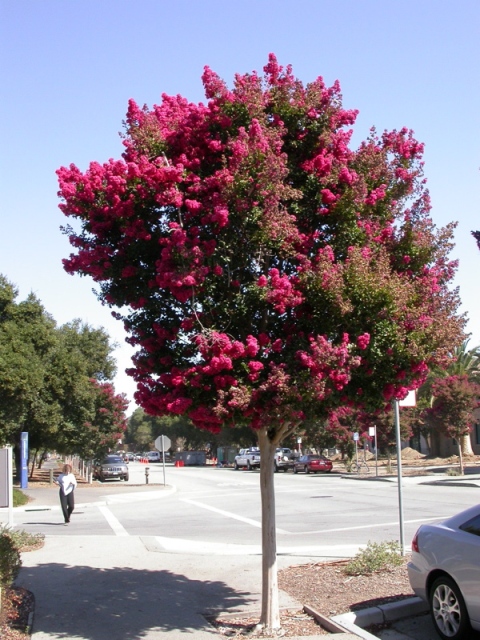Lagerstroemia indica (Crape Myrtle)
Depending on variety, crapes grow as large shrubs or as trees that may be either upright or spreading. The deciduous crape myrtle is among the longest blooming trees in existence with flowering periods lasting from 60-120 days. Crapes come in heights as short as 46 cm and as tall as 12 m. Leaves are alternate and smooth, but leaf size depends on variety. Flowers are borne in summer in big showy clusters and come in white and many shades of pink, purple, lavender and red. The fruits that follow are brown or black. Large varieties are very fast growing .Many types have interesting bark that exfoliates in thin flakes exposing lovely cinnamon or gray inner bark. Crape myrtle likes moist soil, where it will grow exceedingly fast, but it tolerates dry conditions once established. Pruning is recommended only to remove overly dense branches and crossing limbs. Cutting off old flower heads in summer can promote a second and third round of flowering, though. Crape myrtles are a magnet for aphids. Crape myrtles are becoming more widely used in urban areas, especially as new varieties have been developed for smaller size and disease resistance. Used also as a specimen, container plant hedge or screen.
- Landscape Information
- Botanical Description
- Horticulture Management
-
-
Forest & Kim Starr [CC-BY-3.0 (http://creativecommons.org/licenses/by/3.0)], via Wikimedia Commons
-
By KENPEI (KENPEIs photo) [GFDL (http://www.gnu.org/copyleft/fdl.html), CC-BY-SA-3.0 (http://creativecommons.org/licenses/by-sa/3.0/) or CC-BY-SA-2.1-jp (http://creativecommons.org/licenses/by-sa/2.1/jp/deed.en)], via Wikimedia Commons
-
Atamari [CC-BY-SA-3.0 (http://creativecommons.org/licenses/by-sa/3.0)], via Wikimedia Commons
-
Forest & Kim Starr [CC-BY-3.0 (http://creativecommons.org/licenses/by/3.0)], via Wikimedia Commons
-
By Captain-tucker (Own work) [CC-BY-SA-3.0 (http://creativecommons.org/licenses/by-sa/3.0)], via Wikimedia Commons
Search plant on Google
Download as PDF
-
French Name: Lagerstroemia indica
Pronunciation: lay-gur-STREE-mee-uh IN-dick-uh
-
Plant type: Tree
-
Origin: China
-
Heat Zones: 6 to 16
Hardiness Zones: 7 to 11
-
Uses: Specimen, Container, Shade, Wildlife, Street, Pollution Tolerant / Urban
-
Size/Shape
Growth Rate: Moderate
Tree Shape: Vase
Canopy Symmetry: Symmetrical
Canopy Density: Medium
Canopy Texture: Medium
Height at Maturity: 8 to 15 m
Spread at Maturity: 5 to 8 meters
Time to Ultimate Height: 10 to 20 Years
-
-
Forest & Kim Starr [CC-BY-3.0 (http://creativecommons.org/licenses/by/3.0)], via Wikimedia Commons
-
By KENPEI (KENPEIs photo) [GFDL (http://www.gnu.org/copyleft/fdl.html), CC-BY-SA-3.0 (http://creativecommons.org/licenses/by-sa/3.0/) or CC-BY-SA-2.1-jp (http://creativecommons.org/licenses/by-sa/2.1/jp/deed.en)], via Wikimedia Commons
-
Atamari [CC-BY-SA-3.0 (http://creativecommons.org/licenses/by-sa/3.0)], via Wikimedia Commons
-
Forest & Kim Starr [CC-BY-3.0 (http://creativecommons.org/licenses/by/3.0)], via Wikimedia Commons
-
By Captain-tucker (Own work) [CC-BY-SA-3.0 (http://creativecommons.org/licenses/by-sa/3.0)], via Wikimedia Commons
Search plant on Google
Download as PDF
-
Foliage
Leaf Arrangement : Alternate
Leaf Venation: Pinnate
Leaf Persistance: Deciduous
Leaf Type: Simple
Leaf Blade: 5 - 10 cm
Leaf Shape: Ovate
Leaf Margins: Entire
Leaf Texture: Smooth
Leaf Scent: No Fragance
Color(growing season): Green
Color(changing season): Yellow, Orange, Red
-
Flower
Flower Size Range: 10 - 20
Flower Type: Panicle
Flower Sexuality: Monoecious (Bisexual)
Flower Scent: No Fragance
Flower Color: Red, Purple, White, Pink
Seasons: Spring, Summer
-
Trunk
Trunk Susceptibility to Breakage: Generally resists breakage
Number of Trunks: Multi-Trunked, Single Trunk
Trunk esthetic Values: Showy, Fissured
-
Fruit
Fruit Type: Capsule
Fruit Showiness: Yes
Fruit Size Range: 0 - 1.5
Fruit Color: Black
Seasons: Spring, Summer
-
-
Forest & Kim Starr [CC-BY-3.0 (http://creativecommons.org/licenses/by/3.0)], via Wikimedia Commons
-
By KENPEI (KENPEIs photo) [GFDL (http://www.gnu.org/copyleft/fdl.html), CC-BY-SA-3.0 (http://creativecommons.org/licenses/by-sa/3.0/) or CC-BY-SA-2.1-jp (http://creativecommons.org/licenses/by-sa/2.1/jp/deed.en)], via Wikimedia Commons
-
Atamari [CC-BY-SA-3.0 (http://creativecommons.org/licenses/by-sa/3.0)], via Wikimedia Commons
-
Forest & Kim Starr [CC-BY-3.0 (http://creativecommons.org/licenses/by/3.0)], via Wikimedia Commons
-
By Captain-tucker (Own work) [CC-BY-SA-3.0 (http://creativecommons.org/licenses/by-sa/3.0)], via Wikimedia Commons
Search plant on Google
Download as PDF
-
Tolerance
Frost Tolerant: Yes
Salt Tolerance: Poor
-
Requirements
Soil Requirements: Clay, Loam, Sand
Soil Ph Requirements: Acidic, Neutral
Water Requirements: Moderate, Low
Light Requirements: Full
-
Management
Toxicity: No
Susceptibility to Pests and Diseases: Yes
Pruning Requirements: Little needed, to develop a strong structure
Fruit/ Leaves/ Flowers litter: No
Life Span: 25-50 years
Diseases: Powdery Mildew, Leaf Spots
Edible Parts: None
Pests: Aphids
Plant Propagation: Seed, Cutting

